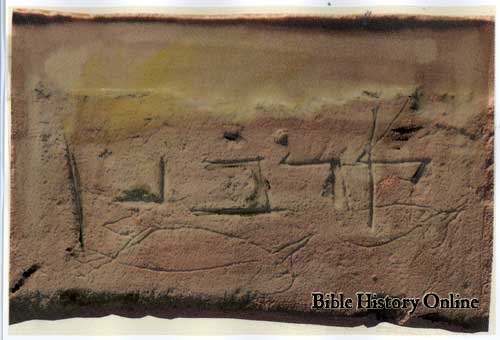Korban Inscription

Does this stone vessel
contain an inscription with the same word used by Jesus "Corban"?
This Korban Inscription is a fragment of a stone vessel excavated at the ruins of the Wailing Wall in Jerusalem.
On the fragment are the 4 Hebrew consonants KRBN (kaph, resh, beth, nun), which spell the Hebrew word "korban" meaning "sacrifice" or "offering". The inscribed word is the same word used by Jesus in Mark 7. With the inscription are two inscribed doves or pigeons. The Korban Inscription is from the time of Jesus and kept at the Israel Museum in Jerusalem. The Korban Inscription discovery is important in the study of Biblical Archaeology because the word is mentioned by Jesus in the New Testament.
Meaning of Korban or CorbanKorban is a name common to any sacred gift; the term in general use to denote sacrifice, its equivalent (Ex 28:38) being "holy gifts." All things or persons consecrated (or vowed) for religious purposes became korban and fell to the sanctuary. The Pharisees taught that "if a man says to his father or his mother, anything of mine you might have been helped by is Corban [i.e., devoted]" (Mk 7:11), he thereby consecrated all to God and was relieved from using it for his parents. This Jesus declared to be contradictory of the command that taught children to honor their parents.
"But ye say, If a man shall say to his father or mother, It is Corban, that is to say, a gift, by whatsoever thou mightest be profited by me; he shall be free. And ye suffer him no more to do ought for his father or his mother; Making the word of God of none effect through your tradition, which ye have delivered: and many such like things do ye." Mark 7:11-13
The Jewish High Priests from 200 B.C to the Reign of Herod the Great
1. Simon II the Just, 220-190 B.C.
2. Onias III, 190-174 B.C.
3. Jason/Jeshua,175-172 B.C.
4. Menelaus, 172-162 B.C.
5. Alcimus, 162-156 B.C.
6. Jonathan, 153-142 B.C.
7. Simon, 142-135 B.C.
8. John Hyrcanus I, 134-104 B.C.
9. Aristobulus I, 104-103 B.C.
10. Alexander Jannaeus, 103-76 B.C.
11. Hyrcanus II, 76-67 B.C.
12. Aristobulus II, 67-63 B.C.
13. Hyrcanus II, 63-40 B.C.
14. Antigonus, 40-37 B.C.
The Jewish High Priests from Herod the
Great to the Destruction of Jerusalem
15. Ananel, 37-36 B.C. (Appointed by Herod the Great)
16. Aristobulus III, 35 B.C.
17. Jesus, son of Phiabi, ? -22 B.C.
18. Simon, son of Boethus, 22-5 B.C.
19. Matthias, son of Theophilus, 5-4 B.C.
20. Joseph, son of Elam, 5 B.C.
21. Joezer, son of Boethus, 4 B.C.
22. Eleazar, son of Boethus, 4-1 B.C. - (Appointed by Herod
Archelaus)
23. Jesus, son of Sie, 1 - 6 A.D.
24. Annas, 6-15 A.D. (Appointed by Quirinius)
25. Ishmael, son of Phiabi I, 15-16 A.D. (Appointed by Valerius
Gratus)
26. Eleazar, son of Annas, 16-17 A.D.
27. Simon, son of Kamithos, 17-18 A.D.
28. Joseph Caiaphas,
18-37 AD.
29. Jonathan, son of Annas, 37 A.D. (Appointed by Vitellius)
30. Theophilus, son of Annas, 37-41 A.D.
31. Simon Kantheras, son of Boethus, 41-43 A.D. (Appointed by Herod
Agrippa I)
32. Matthias, son of Annas, 43-44 A.D.
33. Elionaius, son of Kantheras, 44-45 A.D.
34. Joseph, son of Kami, 45-47 A.D. (Appointed by Herod of Chalcis)
35. Ananias, son of Nebedaius, 47-55 A.D.
36. Ishmael, son of Phiabi III, 55-61 A.D. (Appointed by Herod
Agrippa II)
37. Joseph Qabi, son of Simon, 61-62 A.D.
38. Ananus, son of Ananus, 62 A.D.
39. Jesus, son of Damnaius, 62-65 A.D.
40. Joshua, son of Gamal iel, 63-65 A.D.
41. Matthias, son of Theophilus, 65-67 A.D.
42. Phinnias, son of Samuel, 67-70 A.D. (Appointed by The People)
Some dates cannot be known for certain.
Related Pages:
Corban in Smith's Bible Dictionary
Corban in the ISBE Bible Encyclopedia
Corban in Fausset's Bible Dictionary
Pharisees in Fausset's Bible Dictionary
Vows in Smith's Bible Dictionary
Treasury in the ISBE Bible Encyclopedia
Heart Message - The Paradox of the Priesthood
Caiaphas in Unger's Bible Dictionary
Caiaphas in Easton's Bible Dictionary
Beersheba in the ISBE Bible Encyclopedia
Biblical Definition of Beersheba
Altar - Background Bible Study
Altar in Smith's Bible Dictionary
Altar in the ISBE Bible Encyclopedia
Israel - The Center of the Ancient World
Israel - Archaeology Links and Resources
The Destruction of Israel in the Old Testament
Archaeological Resources - Israel
Free Bible - Fallen Empires (Biblical Archaeology)
Bible History Links - Ancient Near East : Art & Images
Free Bible - Ancient Art
The Destruction of Israel - Kings of Israel, Judah and Assyria
Timeline 800 - 700 BC
The Assyrians
The Captivity of Israel
The Impregnable Strength of Jerusalem
Read The Bible
- 1599 Geneva Bible (GNV)
- 21st Century King James Version (KJ21)
- American Standard Version (ASV)
- Amplified Bible (AMP)
- Amplified Bible, Classic Edition (AMPC)
- Authorized (King James) Version (AKJV)
- BRG Bible (BRG)
- Christian Standard Bible (CSB)
- Common English Bible (CEB)
- Complete Jewish Bible (CJB)
- Contemporary English Version (CEV)
- Darby Translation (DARBY)
- Disciples’ Literal New Testament (DLNT)
- Douay-Rheims 1899 American Edition (DRA)
- Easy-to-Read Version (ERV)
- English Standard Version (ESV)
- English Standard Version Anglicised (ESVUK)
- Evangelical Heritage Version (EHV)
- Expanded Bible (EXB)
- GOD’S WORD Translation (GW)
- Good News Translation (GNT)
- Holman Christian Standard Bible (HCSB)
- International Children’s Bible (ICB)
- International Standard Version (ISV)
- J.B. Phillips New Testament (PHILLIPS)
- Jubilee Bible 2000 (JUB)
- King James Version (KJV)
- Lexham English Bible (LEB)
- Living Bible (TLB)
- Modern English Version (MEV)
- Mounce Reverse Interlinear New Testament (MOUNCE)
- Names of God Bible (NOG)
- New American Bible (Revised Edition) (NABRE)
- New American Standard Bible (NASB)
- New American Standard Bible 1995 (NASB1995)
- New Catholic Bible (NCB)
- New Century Version (NCV)
- New English Translation (NET)
- New International Reader's Version (NIRV)
- New International Version - UK (NIVUK)
- New International Version (NIV)
- New King James Version (NKJV)
- New Life Version (NLV)
- New Living Translation (NLT)
- New Matthew Bible (NMB)
- New Revised Standard Version (NRSV)
- New Revised Standard Version Catholic Edition (NRSVCE)
- New Revised Standard Version, Anglicised (NRSVA)
- New Revised Standard Version, Anglicised Catholic Edition (NRSVACE)
- New Testament for Everyone (NTE)
- Orthodox Jewish Bible (OJB)
- Revised Geneva Translation (RGT)
- Revised Standard Version (RSV)
- Revised Standard Version Catholic Edition (RSVCE)
- The Message (MSG)
- The Voice (VOICE)
- Tree of Life Version (TLV)
- World English Bible (WEB)
- Worldwide English (New Testament) (WE)
- Wycliffe Bible (WYC)
- Young's Literal Translation (YLT)
Main Menu
- Ancient Assyrian Social Structure
- Ancient Babylonia
- Ancient Canaan During the Time of Joshua
- Ancient History Timeline
- Ancient Oil Lamps
- Antonia Fortress
- Archaeology of Ancient Assyria
- Assyria and Bible Prophecy
- Augustus Caesar
- Background Bible Study
- Bible
- Biblical Geography
- Fallen Empires - Archaeological Discoveries and the Bible
- First Century Jerusalem
- Glossary of Latin Words
- Herod Agrippa I
- Herod Antipas
- Herod the Great
- Herod's Temple
- High Priest's in New Testament Times
- Jewish Literature in New Testament Times
- Library collection
- Map of David's Kingdom
- Map of the Divided Kingdom - Israel and Judah
- Map of the Ministry of Jesus
- Matthew Henry Bible Commentary
- Messianic Prophecy
- Nero Caesar Emperor
- Online Bible Maps
- Paul's First Missionary Journey
- Paul's Second Missionary Journey
- Paul's Third Missionary Journey
- Pontius Pilate
- Questions About the Ancient World
- Tabernacle of Ancient Israel
- Tax Collectors in New Testament Times
- The Babylonian Captivity
- The Black Obelisk of Shalmaneser
- The Books of the New Testament
- The Court of the Gentiles
- The Court of the Women in the Temple
- The Destruction of Israel
- The Fall of Judah with Map
- The History Of Rome
- The Incredible Bible
- The Jewish Calendar in Ancient Hebrew History
- The Life of Jesus in Chronological Order
- The Life of Jesus in Harmony
- The Names of God
- The New Testament
- The Old Testament
- The Passion of the Christ
- The Pharisees
- The Sacred Year of Israel in New Testament Times
- The Samaritans
- The Scribes
Ancient Questions
- Why Do the Huldah Gates Appear Different in Ancient Replicas and Modern Photos?
- What Is the Origin of the Japanese and Chinese Peoples? A Biblical Perspective
- How did the ancient Greeks and Romans practice medicine and treat illnesses?
- What were the major contributions of ancient Babylon to mathematics and astronomy?
- How did the ancient Persians create and administer their vast empire?
- What were the cultural and artistic achievements of ancient India, particularly during the Gupta Empire?
- How did ancient civilizations like the Incas and Aztecs build their remarkable cities and structures?
- What were the major trade routes and trading practices of the ancient world?
- What was the role of slavery in ancient societies like Rome and Greece?
- How did the ancient Mayans develop their sophisticated calendar system?
Bible Study Questions
- Why Do Christians Celebrate Christmas?
- How Many Chapters Are There in the Bible?
- The Five Key Visions in the New Testament
- The 400-Year Prophecy: Unpacking Genesis 15 and the Journey of a People
- The Authorized (King James) Version (AKJV): Historical Significance, Translation Methodology, and Lasting Impact
- Exploring the English Standard Version (ESV): Its Aspects, Comparisons, Impact on Biblical Studies, and Church Use
- A Detailed Historical Analysis of Language Updates in the KJ21: Comparison with Other Versions
- A Detailed Historical Analysis of the American Standard Version (ASV): Comparison to the King James Version, Influence on Later Translations, and Evaluation of Strengths and Weaknesses
- A Detailed Historical Analysis of Amplifications in the Amplified Bible (AMP) and Its Comparison to Other Bible Translations
- Detailed Historical Analysis of the Amplified Bible Classic Edition (AMPC): Examples of Amplifications and Comparative Analysis with Other Bible Translations
About
Welcome to Free Bible: Unearthing the Past, Illuminating the Present! Step into a world where ancient history and biblical narratives intertwine, inviting you to explore the rich tapestry of human civilization.
Discover the captivating stories of forgotten empires, delve into the customs and cultures of our ancestors, and witness the remarkable findings unearthed by dedicated archaeologists.
Immerse yourself in a treasure trove of knowledge, where the past comes alive and illuminates our understanding of the present.
Join us on this extraordinary journey through time, where curiosity is rewarded and ancient mysteries await your exploration.
Recent posts
-

Why Discipleship Ministries Matter: How They Shape Churches and Communities
Discipleship ministries have traditionally played an important role in Christians' spiritual growth and the long-term viability of their churches. Chr... -

A Historical Journey of Health Insurance: From Ancient Mutual Aid to Modern Coverage
The modern form of health insurance, which is premium based, pooled risk financial coverage during illness is a relatively new development. But the th... -

Get a Crypto License in Poland - Secure, EU-Ready, and Backed by Prifinance Expertise
Expand your crypto business legally in the European Union with a crypto license in Poland under the MiCA framework. Poland has become one of the most ... -

Why Partnering with the Right Mobile App Development Company Can Make or Break Your Project
Why Partnering with the Right Mobile App Development Company Can Make or Break Your Project In today's hyperconnected world, your app is frequently yo... -

Lion Posters & Canvas Wall Art — The Complete Buyer’s & Styling Guide
Collection Spotlight Lion Posters — Wild, Regal Wall Art for Every Interior A single lion portrait can command a room. A pair of lions can change th...
